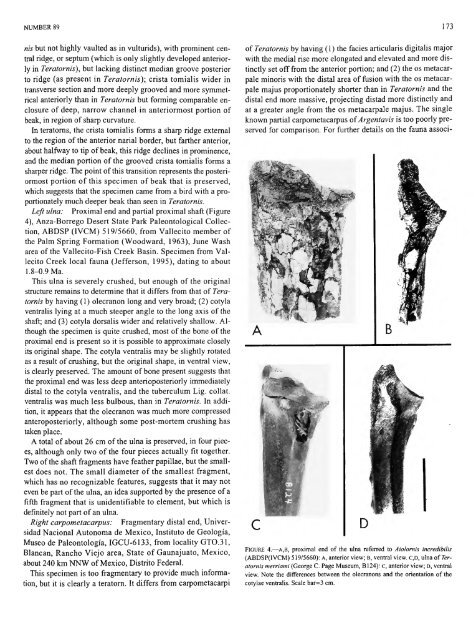PDF (Lo-Res) - Smithsonian Institution Libraries
PDF (Lo-Res) - Smithsonian Institution Libraries
PDF (Lo-Res) - Smithsonian Institution Libraries
Create successful ePaper yourself
Turn your PDF publications into a flip-book with our unique Google optimized e-Paper software.
NUMBER 89 173<br />
nis but not highly vaulted as in vulturids), with prominent central<br />
ridge, or septum (which is only slightly developed anteriorly<br />
in Teratornis), but lacking distinct median groove posterior<br />
to ridge (as present in Teratornis); crista tomialis wider in<br />
transverse section and more deeply grooved and more symmetrical<br />
anteriorly than in Teratornis but forming comparable enclosure<br />
of deep, narrow channel in anteriormost portion of<br />
beak, in region of sharp curvature.<br />
In teratorns, the crista tomialis forms a sharp ridge external<br />
to the region of the anterior narial border, but farther anterior,<br />
about halfway to tip of beak, this ridge declines in prominence,<br />
and the median portion of the grooved crista tomialis forms a<br />
sharper ridge. The point of this transition represents the posteriormost<br />
portion of this specimen of beak that is preserved,<br />
which suggests that the specimen came from a bird with a proportionately<br />
much deeper beak than seen in Teratornis.<br />
Left ulna: Proximal end and partial proximal shaft (Figure<br />
4), Anza-Borrego Desert State Park Paleontological Collection,<br />
ABDSP (IVCM) 519/5660, from Vallecito member of<br />
the Palm Spring Formation (Woodward, 1963), June Wash<br />
area of the Vallecito-Fish Creek Basin. Specimen from Vallecito<br />
Creek local fauna (Jefferson, 1995), dating to about<br />
1.8-0.9 Ma.<br />
This ulna is severely crushed, but enough of the original<br />
structure remains to determine that it differs from that of Teratornis<br />
by having (1) olecranon long and very broad; (2) cotyla<br />
ventralis lying at a much steeper angle to the long axis of the<br />
shaft; and (3) cotyla dorsalis wider and relatively shallow. Although<br />
the specimen is quite crushed, most of the bone of the<br />
proximal end is present so it is possible to approximate closely<br />
its original shape. The cotyla ventralis may be slightly rotated<br />
as a result of crushing, but the original shape, in ventral view,<br />
is clearly preserved. The amount of bone present suggests that<br />
the proximal end was less deep anterioposteriorly immediately<br />
distal to the cotyla ventralis, and the tuberculum Lig. collat.<br />
ventralis was much less bulbous, than in Teratornis. In addition,<br />
it appears that the olecranon was much more compressed<br />
anteroposteriorly, although some post-mortem crushing has<br />
taken place.<br />
A total of about 26 cm of the ulna is preserved, in four pieces,<br />
although only two of the four pieces actually fit together.<br />
Two of the shaft fragments have feather papillae, but the smallest<br />
does not. The small diameter of the smallest fragment,<br />
which has no recognizable features, suggests that it may not<br />
even be part of the ulna, an idea supported by the presence of a<br />
fifth fragment that is unidentifiable to element, but which is<br />
definitely not part of an ulna.<br />
Right carpometacarpus: Fragmentary distal end, Universidad<br />
Nacional Autonoma de Mexico, Instituto de Geologia,<br />
Museo de Paleontologia, IGCU-6133, from locality GTO.31,<br />
Blancan, Rancho Viejo area, State of Gaunajuato, Mexico,<br />
about 240 km NNW of Mexico, Distrito Federal.<br />
This specimen is too fragmentary to provide much information,<br />
but it is clearly a teratorn. It differs from carpometacarpi<br />
of Teratornis by having (1) the facies articularis digitalis major<br />
with the medial rise more elongated and elevated and more distinctly<br />
set off from the anterior portion; and (2) the os metacarpale<br />
minoris with the distal area of fusion with the os metacarpale<br />
majus proportionately shorter than in Teratornis and the<br />
distal end more massive, projecting distad more distinctly and<br />
at a greater angle from the os metacarpale majus. The single<br />
known partial carpometacarpus of Argentavis is too poorly preserved<br />
for comparison. For further details on the fauna associ-<br />
FIGURE 4.—A,B, proximal end of the ulna referred to Aiolornis incredibilis<br />
(ABDSP(IVCM) 519/5660): A, anterior view; B, ventral view. C,D, ulna of Teratornis<br />
merriami (George C. Page Museum, B124): c, anterior view; D, ventral<br />
view. Note the differences between the olecranons and the orientation of the<br />
cotylae ventralis. Scale bar=3 cm.<br />
B

















